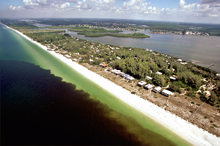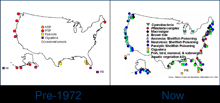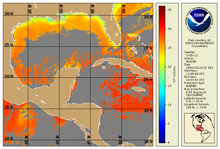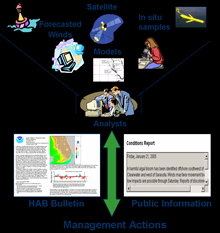Mitigating Harmful Algal Blooms
NOAA, through research, development, and coordination efforts with federal, state, tribal, and academic partners, works to understand, detect, monitor, and predict harmful algal blooms in coastal ecosystems. These advances are helping coastal managers mitigate the detrimental and devastating effects of harmful algal blooms on coastal communities and ecosystems.
While the thought of algae, simple plants that live in the sea and form the base of the food web, may not make you cringe to the theme of "Little Shop of Horrors," some types of algae produce potent toxins that can cause illness or death in humans and marine organisms.

The infamous Florida "red tide" occurs almost annually along portions of the state's Gulf Coast, causing beach and shellfish closures and negatively impacting Florida's tourism industry. Just one harmful algal bloom event can impose millions of dollars in losses upon local coastal communities. Click image for larger view and credit.
Popularly known as "red tides" due to the reddish water discoloration sometimes seen when large concentrations of algae are present, harmful algal blooms (HABs) occur when algae produce toxic or harmful effects on people, fish, shellfish, marine mammals, and birds.
HAB outbreaks can be ecologically, socially, and economically detrimental. HABs can cause the loss of commercially valuable and culturally vital shellfish resources, mortalities of protected marine species such as dolphins and manatees, and human illness and death from consumption of contaminated shellfish. Airborne toxins associated with HABs can also cause respiratory distress, resulting in people avoiding the beaches and disruption of local tourism.

Comparison of major recorded HAB-related events in the United States. As indicated by the map, the variety and extent of HAB incidents has increased in the last few decades. Click image for larger view.
Over the past 30 years, HABs have become a more common problem around the country, and now virtually every coastal state has reported recurring blooms. NOAA is leading efforts to understand, predict, and ultimately mitigate HABs and their impacts.
That Was Then...
Thirty years ago, few tools existed to address harmful algal blooms. Over the course of the next three decades, awareness and understanding of HABs would grow, providing an increasing arsenal of tools to handle blooms.
A Blooming Issue
In 1972, a hurricane resulted in the spread of a large HAB, caused by the toxic dinoflagellate Alexandrium fundyense, throughout the Gulf of Maine. The outbreak caused extensive closures of shellfish beds and threatened to sicken people who consumed contaminated shellfish. That same year, massive "red tide" blooms in Florida, caused by another toxic dinoflagellate, Karenia brevis, threatened public health, causing respiratory disease, contaminating shellfish, and causing severe damage to coral reef communities by depleting oxygen levels in waters near the ocean floor.
At the time, knowledge about how and where HABs form, cause harm, and impact humans and ecosystems was limited. Research efforts to understand HABs were focused mainly in government labs capable of only isolated, small-scale studies. The technology and understanding needed to respond to or mitigate HAB events was not available.
Aside from expensive and time-consuming field sampling and closing entire shellfish beds at the first sign of rising toxin levels, managers were left with few options in handling HABs.
New Tools

HAB research led to the development of the highly successful NOAA CoastWatch program. CoastWatch was the first program in the U.S. to use satellites for routine coastal monitoring. This image shows sea surface temperatures in the Gulf of Mexico on October 29, 2006. Click image for larger view.
In the late 1980s, NOAA was leading the way in developing and supporting capabilities to research and forecast HABs. Tools such as satellites, biochemical detectors, and computer models became available. These tools made it possible to improve the identification of HABs, more effectively monitor the formation and movement of blooms, and provide advance warnings of potential impacts.
Despite these advances, HABs continued to cause millions of dollars of damage every year.
The Harmful Algal Bloom and Hypoxia Research and Control Act
In 1998, Congress passed the Harmful Algal Bloom and Hypoxia Research and Control Act (HABHRCA) to combat the ongoing threat of HABs. This law directed NOAA to advance scientific understanding and the ability to detect, monitor, assess, and predict HAB events.
HABHRCA led to the development and funding of a suite of integrated regional programs that were guided by research and plans involving scientists and managers. For example, large regional ecosystem projects were instituted in Florida and the Gulf of Maine, focusing on understanding the causes, providing resource managers with new tools for monitoring, and developing the capability to predict red tides caused by Karenia brevis and Alexandrium fundyense.
Recent successes in detecting and forecasting HAB events demonstrate the value of these research investments for helping coastal managers in their efforts to reduce and ultimately prevent the detrimental effects caused by these phenomena.
This is Now...

Beach sign developed by Solutions to Avoid Red Tide (START), a local business group concerned with the impacts of red tide on local communities and tourism. Click image for larger view and image credit.
Today, HABs continue to be a major national coastal issue. In 2005, two of the worst HAB events in 30 years occurred along the New England coast and off the west coast of Florida. These blooms caused extensive shellfish closures in New England and respiratory distress, marine mammal mortalities, and widespread low-oxygen water conditions in Florida.
Although the effects of these blooms were serious, the impacts could have been worse. NOAA-supported event response capabilities and long-term regional and targeted research helped coastal managers mitigate these potentially devastating events.
Integrated Tools
In New England, integrated technologies developed over a decade of research were used to greatly enhance response capabilities in the region.
Increased understanding of HAB genetics has led to new methods for rapidly detecting and mapping toxic algae that were used to track the New England bloom in near real time. These data were combined with weather and ocean observations, such as wind and water current speed and direction, and used in computer models to forecast the spread of the bloom, understand the factors leading up to the event, and predict future HAB occurrences.
Information generated from these computer models helped managers to proactively target shellfish toxicity sampling locations as the bloom spread to previously unaffected areas. The safety of seafood was assured and economic losses were minimized by the timely and selective closing and opening of shellfish harvesting.
An Operational System
During the 2005 HAB event in Florida, managers used a new operational system for HABs in the Eastern Gulf of Mexico (the Harmful Algal Bloom Forecasting System). This system, the first of its kind in the U.S., was developed in Florida in 2004, based on NOAA-supported research, development, and testing.

NOAA provides the "HAB Bulletin" to help coastal managers decide where to focus their sampling efforts and prepare for bloom events. The Bulletin has been issued approximately 230 times between October 1, 2004 and August 31, 2006, and continues to be highly valued by managers and the public. Click image for larger view.
The system uses models, together with data from satellite sensors and field and instrument observations from research vessels, to develop the remote sensing methods necessary to monitor and forecast HABs. Bulletins containing this information are developed by integrating data from various ocean-observing systems, including imagery from commercial and government satellites supported by the NOAA Coast Watch Program; meteorological data from NOAA observing stations; and field data collected by state and university monitoring programs. The information is now being produced operationally by NOAA. These bulletins enable coastal resource managers to respond rapidly to conditions that may negatively impact coastal habitats and marine life in their areas. Research is on-going to develop operational HAB forecasting in other regions.
Other Advances
Other advances in HAB mitigation are occurring along the Pacific Northwest coast. New toxin detection capabilities, such as quick field tests based on immunoassays (a laboratory method for detecting a substance by using an antibody reactive to it) rather than time-consuming chemical analyses, are providing advance warning of increasing toxin levels. This advance warning allows the selective opening of shellfish beds; in the past, all locations near a bloom had to be closed as a precaution.
In the Great Lakes region, NOAA research and monitoring efforts are helping to set up an early warning system to detect the presence of algae and toxins before they can impact recreation activities or drinking water supplies.
Conclusion
The research by NOAA and collaborators at state, university, and private labs has led to advanced ecological forecast and mitigation capabilities not possible even a decade ago. NOAA research on HABs continues to make significant advances by supporting research programs and combining the best science within the agency with that of the academic research community. The goals of these integrated studies are to develop tools for coastal managers, resulting in faster HAB event response, reduced losses to coastal communities from those events, and better overall resource management.
Works Consulted
Anderson, D.M., Hoagland, P., Kaoru, Y. & White, A.W. (2000). Estimated annual economic impacts resulting from harmful algae blooms (HABs) in the United States. WHOI Tech. Rept. No. 2000-11.
Smith, G.B. (1975). The 1971 red tide and its impact on certain reef communities in the mid-eastern Gulf of Mexico. Environmental Letters 9(2):141-152.
Steidinger, K.A. & Ingle, R.M. (1972). Observations on the 1971 red tide in Tampa Bay, Florida. Environmental Letters 3:271-278.
